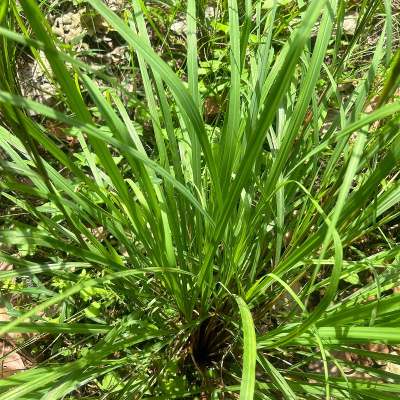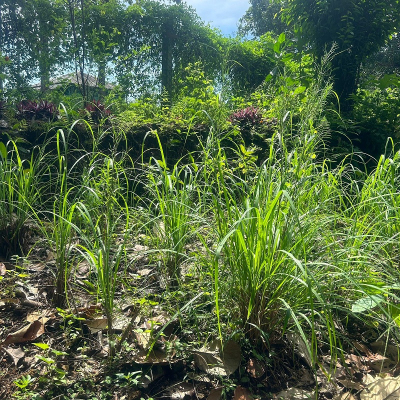Distribution and habitat: Widely distributed throughout the tropics comprising Sri Lanka, Java, Central America, Guatemala, Taiwan, Brazil, East Africa, Congo, Malagasy Republic, The Seychelles, India and West Indies. In India it is cultivated in the States of Assam, West Bengal, Uttar Pradesh, Maharashtra, Karnataka, Tamil Nadu, Gujarat, Arunachal Pradesh, Manipur, Mizoram, Meghalaya, Nagaland and Tripura. The world production of citronella oil is about 7000 tonnes/year; the major producers being Taiwan, China, Indonesia and Guatemala. The chief importing countries are USA, UK, West Germany, Japan and Hong Kong.
Botany:
- Leaf: The leaves are smaller than that of Java type. The plant is a robust, stoloniferous perennial grass, 0.5‑1.0 m high, leaves broad.
- Inflorescence: Panicles large and mostly compound, spikelets awnless, lanceolate and flattened on back.
Properties: Antiseptic, carminative, rubefacien
Chemical constituents: Citronella oil contains citronellal 32‑45%, geraniol 12‑18%, citronellol 11‑15%, geranyl acetate 3.8%, citronellyl acetate 2‑4%, limonene 2‑5%, elemol and other sesquiterpene alcohols 2‑5%, β‑elemene and ‑cadinene 2‑5% and calamenene, bourbonene, bisabolene, eugenol, methyl eugenol, isopulegol, nerol, linalool, geraniol, methyl heptanone, myrcene and ‑pinene. Good quality citronella oils contain more than 38% of citronellal, 16% of geraniol and 12% of citronellol
Agrotechnology
Soil and climate: Cymbopogon nardus var. lenabatu is older form and less important than Java type. It is mainly cultivated in SriLanka. It is hardier and can be grown on poor soils. Citronella grows well under tropical and subtropical conditions. It requires abundant sunshine and moisture for good growth. Even though it grows up to 1000 m above MSL its growth is restricted, resulting in low yields, when grown above an altitude of 400 m. Annual rainfall of 2000‑2500 mm and high atmospheric humidity are ideal for better growth of the plant and quality of the oil. Optimum growth and yield is obtained in sandy loam soil with abundant organic matter. Heavy clay and sandy soils do not support good growth. It grows best on soils with a pH around 6.0. The crop is very sensitive to water‑logging.
Propagation: Propagated only vegetatively by slips which are obtained by dividing well grown clumps. The slips are planted during June‑July at 60‑90 cm spacing and 10 cm deep. Delay in planting results in drying of slips and poor establishment and plant population.
Fertilizers and manures: Farm yard manure is applied at 10 tonnes/ ha before planting. A fertilizer dose of 200 kg N, 80 kg P2O5 and 40‑80 kg K20 is recommended per hectare per annum for optimum growth and yield. Better results are obtained by applying N in 4 equal split doses at an interval of about 3 months. P and K are applied fully as basal.
Irrigation: Irrigation is required within 24 hours of planting . Supplemental irrigation is not required in areas with 2000‑2500 mm rainfall, well distributed over the year. However, in drier months irrigation may be provided for better yield. Depending on weather and soil conditions, 8‑10 irrigations are required in dry areas during the rain free period.
Pests and diseases: Termite attack on planted slips as well as on the live clumps can be controlled by soil application of aldrin or heptachlor at 25 kg/ ha. Leaf blight disease is caused by Curvularia andropogonis (Zimm.) Boedijn. in the beginning of monsoon. It appears as small brownish spots which enlarge into long patches along the tips and margins of the leaves. Another fungus Colletotrichum graminicola (Ces.) Wilson has been found to affect the crop in Karnataka. These diseases can be controlled by prophylactic spraying of Dithane M‑45 or Dithane Z‑78 at 2g/l at an interval of 10‑15 days during the disease prone period.
Harvesting: The crop is ready for the first harvest after about 9 months of planting and subsequently at an interval of 3 months. Harvesting is done by sickle above the first node at 20‑45 cm above the ground. Generally leaf blades are cut and sheath are left out. Flowering should be discouraged as it causes aging and reduces the life span of the plantation. Harvesting can be done 4 times a year. Generally the Java crop once planted yields profitable returns for 4‑5 years and needs replanting only afterwards. Ceylon citronella remains productive for 10‑15 years. Uprooting of the plantation after its life span and rotation with any legume species is recommended. Horse gram, cowpea and sunhemp are good rotational crops.
Processing: The harvested grass is wilted in shade for a short time and steam distilled within 24 hours. The oil yield varies with the season, soil fertility and distillation efficiency. On an average, 0.8‑1.2% of oil is recovered from the grass and the oil yield is about 100 kg/ ha during the first year and 150 kg/ ha during subsequent years. Yields of 200‑250 kg/ ha/ yr can be obtained under favourable conditions with good management. Oil is of inferior quality with a lower citronellal content compared to java type.




